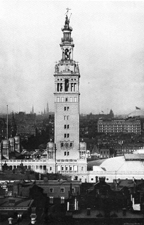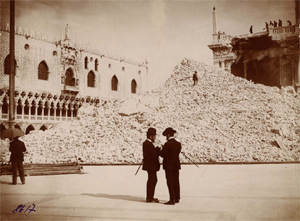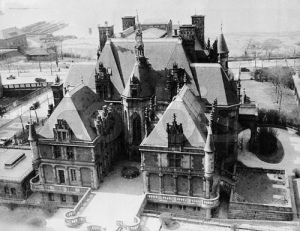
The photographer Ernst Haas criticized the act of copying as an act of losing the self. In art, however, the need for constant revolution in design can lead only to a series of fleeting fashions. If what was done before us is constantly thrown away, there isn’t much hope in our creations having a reach beyond our own time.
This is particularly relevant to architecture, and it came to mind while viewing images of Stanford White’s Madison Square Garden at a Metropolitan Museum of Art exhibition about Augustus Saint Gaudens.
The Madison Square Garden tower looked much like the Giralda Tower in Seville, Italy. I would add that White’s version was more sleek and dare I say attractive than the original. I suspect a desire in this, a young country, for world-class monuments brought on the design. While this, the second incarnation of Madison Square Garden would last for only 34 years, the Giralda Tower, designed in 1184, exists today.

Another New York tower that pulled on inspiration from earlier times is the Metropolitan Life Tower. Unlike Madison Square Garden, this one is located on Madison Square. The Campanile in Venice, Italy served as an inspiration when the building was commissioned by the Metropolitan Life Insurance Company in 1907. This attractive building exists today, though hasn’t served as the company headquarters since 2005. It now houses condominiums. The Campanile reached its present form in 1514. Certinly when something falls down in the U.S., that furthest thing from our minds is rebuilding it as it was. Not so in Italy. Recreated in 1912, the existing Campanile has lasted longer than most of the American recreations. The original collapsed in 1902, killing one cat.
The Sather Tower at U.C. Berkeley and the city hall in Springfield, Massachusetts were also modeled on Campanile.
Life insurance companies haven’t been good to New York’s architectural treasures. It was New York Life who brought on the demise of White’s Madison Square Garden (although White’s own demise in the building was brought on by a jealous husband, Harry Thaw). It was Prudential that brought on the demise of the Riverside Drive home of Charles M. Schwab of Bethlehem Steel.
Designed by French architect Maurice Hebert in the French Renaissance château style, and was based on the three Loire Valley châteaux of Chenonceaux, Blois, and Azay-le-Rideu in France (as if you couldn’t guess the location by the names). The most ambitious private house ever built in New York, the 75 room “Riverside” included a swimming pool, chapel art gallery, parking for four vehicles and a separate entrance for delivery of goods. After Schwab’s death, New York mayor Fiorello La Guardia turned down a proposal to make the mansion the official mayoral residence. Prudential sent in the wreckers and replaced Schwab’s home with twin apartment towers, built with Bethlehem beams.
The monuments to Charles M. Schwab and Maurice Herbert and the masterpiece of Stanford White are all gone. In this environment, builders and architects should hardly expect there will be a legacy that reaches far into the future. In fact, the bland, utilitarian apartment towers that replaced Schwab’s Riverside have outlasted the work of the great men and master builders.
p.s. Another Italian inspired tower in the U.S. can be found in Baltimore’s Bromo Seltzer Tower. The design of the tower along with the original factory building at its base was inspired by the Palazzo Vecchio in Florence. The factory building has since been demolished, but the tower remains an attractive part of the city’s skyline.
Discover more from Urban Art & Antiques
Subscribe to get the latest posts sent to your email.


